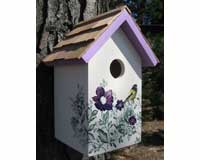Many of the birds that visit feeders and baths may stay and nest in nearby trees. Most of them, including cardinals, doves and orioles, don't nest in boxes. You can still help them by considering their food and shelter requirements in your landscape plans. You can also hang out a wire cage full of nesting materials (fiber scraps, twigs, wool, or feathers) in the spring.More than two dozen North American birds will nest in bird houses. The following descriptions will help you determine which birds might visit your neighborhood.
Bluebirds
If you put up a bluebird birdhouse near an old field, orchard, park, cemetery, or golf course, you'll have a good chance of attracting a pair of bluebirds. They prefer nest boxes on a tree stump or wooden fence post between three and five feet high. Bluebirds also nest in abandoned woodpecker nest holes. The most important measurement is the hole diameter. An inch and a half is small enough to deter starlings. Starlings and house sparrows have been known to kill baby bluebirds as well as adults sitting on the nest.
Bluebirds have problems with other animals too. The easiest way to discourage predatory cats, snakes, raccoons, and chipmunks is to mount the house on a metal pole, or use a metal predator guard on a wood post.
Robins
Robins are our largest thrushes. They prefer to build their nest in the crotch of a tree. If you don't have an appropriate tree, you can offer a nesting platform or bird houses. Pick a spot six feet or higher up on a shaded tree trunk or under the overhang of a shed or porch. Creating a "mud puddle" nearby offers further excitement as robins use mud to line their nests.
Chickadees, Nuthatches, and Titmice
 Chickadees, titmice, and nuthatches share the same food, feeders, and habitats. If you put a properly designed the nest box in a wooded yard, at least one pair is sure to check it out.
Chickadees, titmice, and nuthatches share the same food, feeders, and habitats. If you put a properly designed the nest box in a wooded yard, at least one pair is sure to check it out. Put chickadee birdhouses at eye level. Hang them from limbs or secure them to tree trunks. The entrance hole should be 1-1/8" to attract chickadees yet exclude house sparrows. Anchor the birdhouses for hatches on tree trunks five to six feet off the ground. You can encourage these birds to stay in your yard by continuing to fill your suet and peanut feeders through the summer.
Wrens
 Wrens don't seem to be very picky about where they nest. Try birdhouses with a 1" x 2" horizontal slot (1-1/2" x 2-1/2" for the larger Carolina wrens) instead of a circle. These are easier for the wrens to use.
Wrens don't seem to be very picky about where they nest. Try birdhouses with a 1" x 2" horizontal slot (1-1/2" x 2-1/2" for the larger Carolina wrens) instead of a circle. These are easier for the wrens to use. Wrens are notorious for filling up any conceivable nest cavity with twigs, regardless of whether they use the nest. Since male house wrens build several nests for the female to choose from, hang several wren birdhouses at eye level on partly sunlit tree limbs. Wrens are sociable and will accept nest boxes quite close to your house.
Visit www.aboutbirdhouse.com to check on many great birdhouses for your yard.









